Journal of Financial Planning: April 2014
Ronald A. Sages, Ph.D., AEP®, CFP®, CTFA, is an instructor of personal financial planning at Kansas State University, and president and chief investment officer of Chapin Asset Management Inc., a wealth management firm with offices in Greenwich, Connecticut and Hilton Head Island, South Carolina. He teaches in the CFP registered master’s and certificate programs, and conducts research in behavioral finance related to self-esteem, financial literacy, and risk management.
Martin C. Seay, Ph.D., CFP®, is an assistant professor of personal financial planning at Kansas State University. He teaches in the CFP registered undergraduate and Ph.D. programs while conducting research on a broad array of financial planning topics.
Acknowledgment: The authors acknowledge and thank Andrew D. Ellis of Arthur-Green LLP, in Manhattan, Kansas, for his invaluable assistance in the review of this manuscript.
Executive Summary
- Portability has been made permanent under the provisions of the American Taxpayer Relief Act of 2012.
- The administrative requirements and potential expenses associated with making the portability election for more modest estates can be potentially overwhelming and costly. Family harmony may also play an important role in the decision to elect portability.
- Financial planners working with estate planning attorneys to guide testators who reside in jurisdictions that have decoupled from the federal estate tax system may now need to focus more closely on state estate tax laws as well in designing their clients’ estate plans.
- This paper explores some of the issues confronting financial planners, executors, and heirs of decedents’ estates when making the portability election on the federal estate tax return.
A little more than one year ago, the U.S. Treasury Department issued temporary regulations governing the provisions dealing with “portability” under Internal Revenue Code Section §2010(c). The concept of portability was introduced under the Tax Relief, Unemployment Insurance Authorization, and Job Creation Act of 2010 (TRA 2010), permitting the transfer of a deceased spouse’s unused applicable exclusion amount (formerly the “applicable credit amount”) to the surviving spouse for use either during life or at death. The portability provision was originally due to sunset on December 31, 2012. As calendar year 2012 drew to a close, few financial planning practitioners and estate tax attorneys expected portability to survive tax reform. Indeed, many expected higher income and transfer tax rates to take effect in the new calendar year.
Taxpayers awoke on January 1, 2013 to discover that a vast array of tax provisions had been agreed to on a bipartisan basis by Congress; among these provisions was an increase in the applicable exemption amount to $5.25 million ($5.34 million in 2014) for gifts made and decedents dying after December 31, 2012. In addition, the concept of portability was resurrected and made a permanent provision of the Internal Revenue Code, all as part of the American Taxpayer Relief Act of 2012 (ATRA 2012).
In the early days following initial enactment of portability under TRA 2010, some commentators felt that the need for more sophisticated estate planning among modest, and even not-so-modest, estates of couples was no longer necessary (Sullivan 2013). In 2011, upwards of $10 million could potentially have been transferred at the death of the surviving spouse without the imposition of federal estate taxation. However, as financial planners well know, there are myriad reasons for estate planning, tax considerations aside.
The Practicality of the Law
Given the surprising turn of events affecting estate planning reform under ATRA 2012, the temporary regulations governing portability are now worth of a much closer look. To take advantage of portability, the executor of a deceased spouse’s estate must irrevocably (§20-2010-2T(a)(4)) elect to transfer the deceased spouse’s unused exclusion (DSUE) amount to the surviving spouse on a timely filed, complete, and properly prepared federal estate tax return that calculates the unused amount remaining (§20-2010-2T(a)(1)-(2)).
Under the temporary regulations, a portability election may not be made if the federal estate tax return is filed after the time prescribed by law, including any extensions granted, for filing the return. Typically, a decedent’s federal estate tax return (Form 706) is due, and tax liability must be paid, within nine months following the date of death. An automatic six-month extension of time to file may be requested by the executor of the estate within the initial nine-month period following death.
Previously, a federal estate tax return was required to be filed if the sum of the taxpayer’s gross estate, adjusted taxable gifts, and any allowed specific exemption exceeded the applicable exclusion amount (IRC §6018(a)). The temporary regulations make clear that a federal estate tax return (Form 706) must now also be timely filed to preserve and transfer a deceased spouse’s unused applicable exclusion amount to a surviving spouse. For estates that wish to opt out of portability, the executor may affirmatively state on a timely filed federal estate tax return, or attach a statement to a timely filed federal estate tax return, that the estate is not electing portability under IRC §2010(c)(5). Alternately, if the filing of a federal estate tax return is not otherwise required, simply permitting the nine-month period following the date of death to lapse will be sufficient to opt out of portability. Part 6 of Form 706 has now been added to the estate tax return to enable executors to comply with the provisions of the Treasury Department’s temporary regulations.
In general, portability simplifies the age-old asset ownership dilemma, because the ownership of assets between spouses becomes less of a concern in the estate of the first spouse to die for federal death tax purposes. In addition, portability permits assets to receive a partial or full basis step-up at the death of the first spouse, depending on the form of asset ownership, as well as a full basis step-up at the death of the surviving spouse.
One of the more onerous and time consuming requirements associated with the preparation of Form 706 is that of asset valuation. For estates not otherwise required to file a federal estate tax return, a special rule exists permitting the estate executor to only report specific information pertaining to the ownership and identification of assets, without valuation, and be eligible for the federal marital (IRC §2056) or federal charitable (IRC §2055) deductions. All other assets not passing via the marital or charitable deduction must be valued in accordance with Treasury regulations §20.2031. In addition to this, the executor is required to provide a due diligence estimate of the value of the gross estate, rounded to the nearest $250,000 within ranges to be contained in the instructions to Form 706.
In theory, this special rule provides a degree of simplification for executors of estates embracing portability. However, it is likely that investable assets pouring into a qualified terminable interest property (QTIP) marital trust will nevertheless need to be properly valued (see Treasury reg. §20.2031-2) to establish the basis for fiduciary income tax purposes, thereby requiring additional administrative costs. This will especially be true in instances where a professional fiduciary is named to serve as sole or co-trustee of the QTIP marital trust arrangement.
A computation of the DSUE amount must also be made and included with the federal estate tax return so that the surviving spouse may know the amount of the decedent’s DSUE that may be taken into account.1
What’s the Impact?
Although no one can precisely predict the number of decedents dying in the future or the gross estate sizes of those decedents, it may be interesting to look at the number of federal estate tax returns filed in 2008 and 2009 (the most recent data made available in summary form by the IRS) to gain some sense of the impact the addition of the DSUE federal estate tax filing requirement may have upon decedents’ estates in the future. The applicable exclusion amounts for estates in 2008 and 2009 were $2 million and $3.5 million, respectively, while the decoupled gift tax applicable exclusion amount in each year was $1 million. The annual exclusion amounts for present interest gifts during these calendar years were $12,000 and $13,000, respectively.
Table 1 illustrates that more than one half of all federal estate tax returns filed in 2008 and 2009 were beneath $5 million gross estate tax value. This translates into 25,000 plus federal estate tax returns filed in each year that, beginning January 1, 2013, would not need to be filed, but for the DSUE portability requirement.
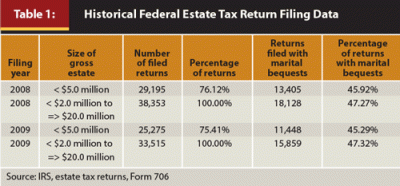
It is also worth noting that these figures reflect decedents’ estates that were required to file in those years. There were many more decedents in those two years whose estates were beneath the respective federal estate tax filing requirement. In 2014, estates beneath the $5.34 million threshold will definitely have DSUE remaining at the death of the first spouse and be candidates for the portability election.
Two important points are worth repeating: (1) The portability election may only be made by filing a timely federal estate tax return, and (2) once made, the portability election becomes irrevocable when the due date of the federal estate tax return, including extensions granted, has passed.
In decedents’ estates where over-qualification of the marital deduction occurs—either by design or by default—an analysis and decision must be quickly made regarding whether or not to make the portability election. If the gross estate plus adjusted taxable gifts and specific exemption exceeds $5.34 million in value in 2014, a federal estate tax return is required to be filed regardless of portability considerations. The 2008 and 2009 filing data, however, shows a mean number of federal estate tax returns filed, where marital deduction bequests were claimed, totaled 16,993. Of this number, approximately 45 percent in each year represented returns that were under $5 million in gross estate value.
Potentially Perilous Pitfalls
Family dynamics. A question to be answered revolves around the willingness of estate executors, and/or heirs, to incur the expense and time necessary to have a federal estate tax return prepared, where one would not otherwise be necessary if not for the portability election.
In an existing second or subsequent marriage, planners should query whether or not the heirs (other than the surviving spouse) of the first decedent spouse would be willing to incur the added expense of preparing a federal estate tax return for the purpose of making the portability election, which may likely solely benefit the heirs of the surviving spouse, not the first decedent spouse.
For example, assume John and Mary are married. Each had been married previously and has adult children from the first marriage. John passes away with a gross estate of $2.5 million, which passes under his will to his children from his first marriage. Mary has an estate of $7.5 million, which will ultimately pass at her death to her children from her first marriage. John’s estate does not need to file a federal estate tax return, because it falls beneath the applicable exclusion amount. No federal estate tax will be due. However, Mary’s estate exceeds the current applicable exclusion amount, and her heirs would benefit from a portability election in John’s estate of his DSUE amount. Will John’s children be willing to incur the expense and possible delay in distribution of assets to have a federal estate tax return prepared for the purpose of making a portability election that will not benefit them in any way? If blended family harmony is sound, this may not be a significant issue. There may be potential, however, for blended family acrimony where the portability election is of much greater importance to the surviving spouse’s family and estate plan design, especially where the surviving spouse’s estate is substantially larger than the estate of the first decedent spouse.
Interestingly, this places the executor of the decedent’s estate in a potentially precarious position. If the executor expends estate funds in an otherwise non-reportable estate to have the decedent’s DSUE amount transferred to the surviving spouse where the descendants have different parents, is there potential for surcharge? If the executor fails to apply the decedent’s DSUE amount to the surviving spouse, especially in a subsequent marriage situation, is the executor subject to litigation by the heirs of the surviving spouse? Further, in time, is it possible that the concept of a DSUE could become a “property right” that is subject to negotiation in a prenuptial agreement where blended families are involved?
Additionally, many jurisdictions have adopted statutes affording an expedited, abbreviated, and cost-effective probate process for very modest estates. In these instances, an executor is usually not appointed, as the heirs at law will petition the local probate or surrogate’s court to have the decedent’s property transferred accordingly. The temporary regulations provide that in the absence of an appointed executor, any person (“a non-appointed executor”) in actual or constructive possession of any property of the decedent may file the estate tax return on behalf of the estate of the decedent and, in so doing, elect portability of the decedent’s DSUE amount, or, conversely, may elect to not have portability apply (Treasury reg. §20.2010-2T(6)(ii)). After a portability election has been made by a non-appointed executor, it cannot be superseded by a subsequent, contrary election by another non-appointed executor of the same estate.
This latter provision may encourage a literal “race to the post office” by family members or heirs, including the surviving spouse, to preserve or waive the portability election in the decedent’s estate. It appears that the first filed Form 706 by a non-court appointed “person in possession,” within the allotted time frame, wins.
Asset composition. Another potential issue emerges in harmonious family environments where the combined assets between spouses do not exceed $10.68 million in 2014. If the first decedent spouse’s estate consists of rapidly appreciating assets, does it continue to make sense to establish and fund a bypass trust in the estate of the first spouse to die? This strategy will take advantage of the first decedent spouse’s applicable exclusion amount, but it will do so at the expense of a future basis step-up at the surviving spouse’s death. Alternately, by deliberately electing portability now in the estate of the first decedent spouse, the step-up in basis is preserved at the subsequent spouse’s death, assuming the surviving spouse does not remarry, the combined spousal assets don’t appreciate above $10.68 million (as indexed for inflation), and/or the decedent spouse’s generation-skipping transfer (GST) tax exemption is not an important technique in the estate plan, as portability does not apply to any unused GST tax exemption.
In situations when the assets owned by the first spouse to die are likely to rapidly appreciate, establishing a credit shelter trust in the first estate may translate into a more efficacious use of the applicable exclusion amount. Because the DSUE amount is not indexed for inflation, transferring rapidly appreciating assets to a surviving spouse will ultimately consume more of the DSUE amount in exchange for a fresh basis step-up. Using a non-marital trust in the estate of the first spouse will protect all future appreciation of those assets from further transfer taxation and permit allocation of the first decedent spouse’s unused GST tax exemption. Any remaining DSUE amount, after funding the credit shelter trust, may be allocated to the surviving spouse. It is important to note that, although a taxpayer’s applicable exclusion amount will be indexed annually for inflation,2 the DSUE amount, once calculated, becomes permanently fixed at its value that is finally determined in the deceased spouse’s federal estate tax return.
Decoupled states. Since the passage of the Tax Reform Act of 1986, the death tax focus of many estate planners and probate attorneys has been on minimizing federal transfer taxes. Since the passage of ATRA, the biggest challenge facing many of these professionals will be deciding how to handle portability where the decedent was domiciled in a state that has “decoupled” from the federal estate tax regime (Rico 2013).
Decoupling occurred in the mid-2000s as a result of the Economic Growth and Tax Relief Reconciliation Act of 2001 (EGTRRA).3 The act called for the elimination of the long-standing state death tax credit in exchange for a state death tax deduction. As of this writing, approximately 19 states,4 plus the District of Columbia, have decoupled and/or have formed their own estate/inheritance tax system, incorporating either a similar, independent, or lower applicable exemption amount, as well as additional regulations involving marital deduction bequests (Saunders 2013). At present, only the state of Hawaii has adopted portability legislation of its own.5
Decoupling requires the estate fiduciary to decide whether or not to elect portability at the federal level and forgo the use of a state applicable exemption amount, or to employ a blend of techniques designed to minimize overall federal and state death taxation. While the estate tax result in the estate of the first decedent to die is the same under any decision, it is in the estate of the second spouse to die that death taxes may become greater.
For example, assume that a married couple has combined assets totaling $2 million. The couple is domiciled in a state where the state applicable exemption amount is $1 million. Currently, there will be no federal estate tax liability at either death, unless the surviving spouse subsequently receives a major windfall. However, if the executor of the estate of the first spouse to die elects portability, the surviving spouse’s estate will exceed the state applicable exemption amount and a state estate tax liability will be due. Had the executor funded a $1 million credit shelter trust in the estate of the first spouse to die, and elected portability for the remaining DSUE amount of this spouse, there would be no federal or state death tax payable upon the death of the surviving spouse, assuming no appreciation of assets owned by the surviving spouse between the first spouse’s death and the surviving spouse’s death.
Larger estates in a decoupled state may have a broader array of choices in estate tax planning. Take the example of a married individual who dies with a gross estate of $7 million, and who resides in a decoupled state with a $1 million state applicable exclusion amount (see Figure 1). Barring any state conformity requirements (discussed in the next section), the executor of the estate may elect to create a $1 million credit shelter trust using both state and federal applicable exemption amounts, a $4.34 million “gap” trust, against which a state but not federal QTIP election is made, and the balance of $1.66 million in a bequest form (outright or in trust) qualifying for both the federal and state marital deductions. Alternately, the decedent’s will may create a $1 million credit shelter trust using both state and federal applicable exemption amounts, and pass the remainder of the gross estate into an arrangement qualifying for both federal and state marital deduction allowances. The executor would elect portability for the decedent’s remaining DSUE amount.
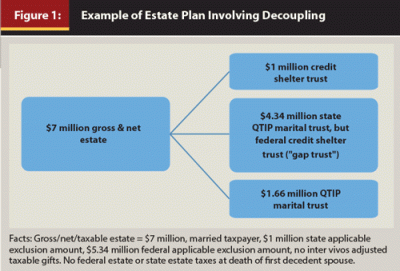
Decoupling and conformity. Decoupling becomes a bit more complex in states that have adopted conformity requirements for the marital deduction, such as New York and New Jersey (Steiner and Shenkman 2013). The principle of conformity provides that a QTIP election made over specific assets on a federal estate tax return must also be made over the same assets on the state estate tax return. In this instance, a gap trust (as previously discussed), where a state but not federal QTIP election is made is not permissible, because state law requires that a QTIP marital election made for federal estate tax purposes must also be made for state estate tax purposes.
For larger decedents’ estates, conformity compels the executor to either elect a marital arrangement for the assets in the gross estate exceeding the state applicable exclusion amount, or incur a state estate tax at the death of the first spouse to die, as shown in Figure 2.
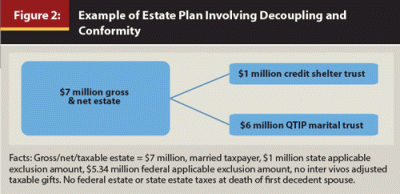
Generation-skipping transfer tax exemption considerations. Regardless of the combined sizes of married couples estates, full use of portability in the estate of the first spouse to die, combined with an outright or general power of appointment marital bequest, effectively waives the GST tax exemption in the estate of the first spouse to die. Because the GST tax exemption amount is not subject to the application of portability, it becomes a use-it-or-lose-it proposition in the estate of the first spouse to die.
Prior to the advent of portability, a common approach in estate planning for married couples (see Figure 3) was to fund a credit shelter trust equal to the decedent spouse’s applicable exclusion amount remaining at death, and apply that portion of the decedent spouse’s GST tax exemption to the credit shelter trust, resulting in an inclusion ratio of zero. A second trust was created in the form of a QTIP marital trust in an amount equal to any remaining portion of the decedent spouse’s GST tax exemption after making an allocation to the credit shelter trust. The executor would make a reverse QTIP election for this second trust under IRC §2652(a)(3), giving it an inclusion ratio of zero as well, but making it fully includible in the surviving spouse’s estate for federal estate tax purposes.
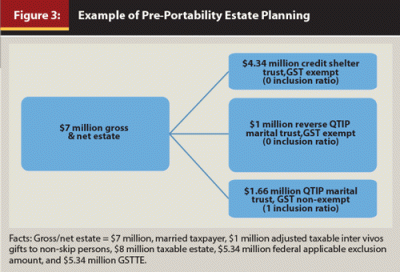
With a reverse QTIP trust, the first decedent spouse will be regarded as the transferor of assets for GST tax purposes only, but not for federal estate tax purposes. The reverse QTIP election may only be made for a QTIP marital trust, not for a general power of appointment marital trust. Any remaining assets not used to fund the credit shelter and reverse QTIP trusts but owned by the first decedent spouse would then pass into a third trust, also in the form of a QTIP marital arrangement, which would be fully includible in the surviving spouse’s estate for federal estate tax purposes, and which would contain an inclusion ratio of one (see Figure 3).
Now that portability has entered into the equation, a conscious decision must be made on how to structure the dispositive provisions of an estate plan to potentially leverage the benefits of all exemptions and exclusions.
Use of portability, coupled with a QTIP marital arrangement, could potentially reduce the number of trusts in the pre-portability example to two, consisting of a reverse QTIP marital trust (zero inclusion ratio) and a QTIP marital trust (inclusion ratio of one), as shown in Figure 4. This example uses the same facts as those just discussed. In this manner, the first decedent spouse’s GST tax exemption will be employed and basis step-up will be available for assets remaining in both trusts at the death of the surviving spouse. However, it is worth mentioning again that, at the death of the surviving spouse, the combined value of assets in both trusts, excluding any depreciation or appreciation, may exceed the combined value of the surviving spouse’s applicable exclusion amount plus the DSUE amount from the first decedent spouse.
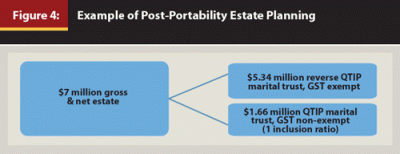
Revenue Procedure 2001-38. In 2001, the Internal Revenue Service set forth its position, in Revenue Procedure 2001-386, to nullify a QTIP election made by an executor of an estate of a first spouse to die, where the applicable exclusion amount remaining at death was wholly adequate to eliminate any federal estate tax liability without use of the QTIP election. This IRS position was established in response to many requests the IRS received from surviving spouses where the applicable exclusion amount in the estate of the first spouse to die was largely unused.
In the context of portability, many estate planning practitioners have questioned whether or not the IRS would automatically disregard a QTIP marital election, coupled with a portability election, pursuant to the IRS’s own position in Rev. Proc. 2001-38. The Real Property, Trust, and Estate Law section of the American Bar Association recently wrote to the IRS to provide comments and recommendations on practical modifications to its position when a portability election is made in conjunction with a QTIP marital election. On an informal basis, the IRS has signaled that it will not capriciously invoke the provisions of Rev. Proc. 2001-38 to frustrate taxpayer estate plans. However, until the IRS formally alters or reconfirms its position as contained in Rev. Proc. 2001-38, financial planning practitioners should proceed with caution when working with married clients whose taxable estates are projected to be within the allowable applicable exclusion amount.
Remarriage conundrum. Careful consideration must be given in cases where portability has been elected and a surviving spouse has remarried. Portability rules dictate that a surviving spouse may only use the DSUE amount from the last deceased spouse (§20.2010-1T(d)(5)). This provision prevents the compounding and aggregation of unused applicable exclusion amounts accruing from multiple prior marriages, but may serve to complicate a previously completed estate plan.
If a surviving spouse remarries, and the subsequent spouse passes away before the surviving spouse can fully use the first deceased spouse’s DSUE amount, any unutilized DSUE amount from the first deceased spouse is forever lost. Where a possible remarriage of the surviving spouse is likely, consideration must be given to embarking upon a lifetime gifting program to avoid the possibility that the new spouse predeceases the surviving spouse from the first marriage, thereby causing a loss of the portability amount. Further, additional consideration may need to be given to the form of marital bequest best suited to enable the surviving spouse to embark upon such a lifetime gifting program.
Conclusions
Based on the potential pitfalls identified in this article, the following are items a financial planner should consider when consulting with an estate planning attorney to generate estate plans:
- When working with blended families, consideration must be given to the advisability of electing portability in less than harmonious family environments, administrative costs notwithstanding.
- When deciding whether to elect portability, consider net tax consequences in light of expected asset appreciation, current estate tax rates and applicable exemption amount, and the expected income tax consequences of the disposition of property.
- When practicing in a state with a state estate tax, consider estate plans within the context of state estate tax rates and the exemption amount to minimize total estate tax exposure given the lack of portability at the state level. This requires additional attention when working in states that have decoupled from the federal estate tax system or that require conformity with federal estate tax laws.
- In cases where significant assets will be exposed to GST tax exemptions upon the death of the surviving spouse, consider constructing an estate plan to maximize those exemptions upon the death of the first spouse, which may require using the estate tax exemption and altering the overall estate plan.
- In light of Rev. Proc. 2001-38, consider the potential consequences of the nullification of QTIP elections and adjusting estate plans accordingly until further guidance is provided.
- In cases of remarriage, consider the benefits of accelerating the use of any remaining DSUE amounts from previous marriages.
In summary, the permanence of portability legislation under ATRA 2012 can be of significant benefit to many married taxpayers. As is the case with any aspect of tax planning, competent professional legal and tax advice should be sought. However, it is safe to say that portability is not a substitute or cure-all that can take the place of proactive estate planning, regardless of the size of clients’ estates. Further, in jurisdictions where decoupling and conformity provisions come into play, estate planning must now necessarily consider the impact of state estate tax legislation in the design and execution of testators’ dispositive wishes.
Endnotes
- 20.2010-2T(b)(1).
- §20.2010-1T(3).
- The Economic Growth and Tax Relief Reconciliation Act of 2001, (Pub. L. 107-16, 115 Stat. 38, June 7, 2001).
- Connecticut, Delaware, Hawaii, Illinois, Iowa, Kentucky, Maine, Maryland, Massachusetts, Minnesota, Nebraska, New Jersey, New York, Oregon, Pennsylvania, Rhode Island, Tennessee, Vermont, and Washington, as well as the District of Columbia have enacted a separate estate tax system, a modified pick-up tax on non-spousal transfers with unique applicable exemption amounts, and/or an inheritance tax system. For instance, Maryland and New Jersey have both modified pick-up taxes and inheritance taxes.
- Haw. Rev. Stat. §§ 236D-3, 236D-2.
- Rev. Proc. 2001-38, 2001-1 C.B. 1335, although not binding on other taxpayers; see also PLR 201345006.
References
Rico, Lisa M. 2013. “Estate Planning with Portability in Decoupled States.” Probate and Property Magazine 27 (3): 22–29.
Saunders, Laura. 2013 (October 25). “States You Shouldn’t be Caught Dead in.” The Wall Street Journal.
Steiner, Bruce D., and Martin M. Shenkman. 2013. “Estate Planning in Decoupled States Post-ATRA.” Trusts & Estates 152 (8): 13–17.
Sullivan, Paul. 2013 (January 4). “The End of a Decade of Uncertainty over Gift and Estate Taxes.” The New York Times.
CITATION
Sages, Ronald, and Martin C. Seay. 2014. “The Practical and Potentially Perilous Pitfalls of Portability.” Journal of Financial Planning 27 (4) 56-62.